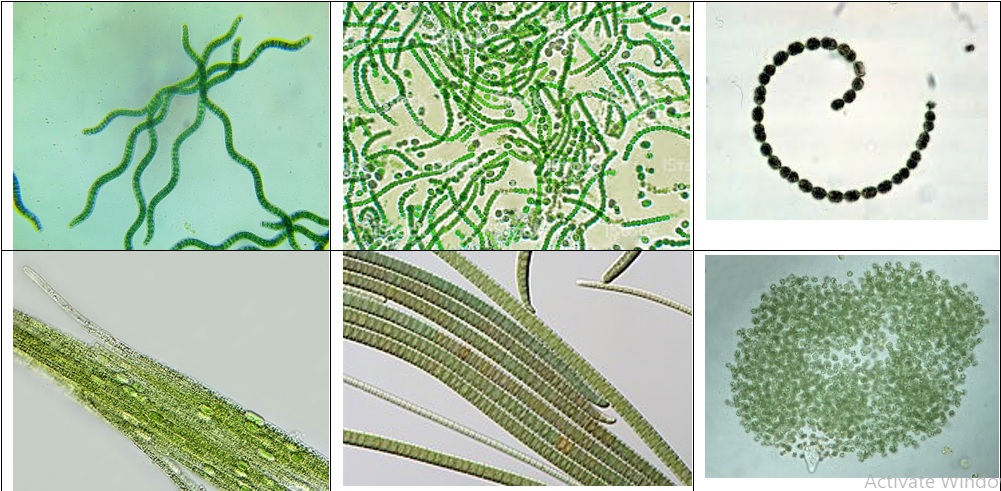Cyanophyta is a type of plankton or algae with a dominant green pigment so it is often referred as blue green algae. Cyanophyta is also referred to as Cyanobacteria. The term Cyanobacteria is an organism with properties between bacteria and algae, which is capable of photosynthesis, but has a cell structure like bacteria. Cyanophyta is the oldest living thing that plays a major role in the biogeochemical cycles and is the only group of organisms capable of binding nitrogen from the air through heterocysts.
Cyanophyta is easily found in various environments because it can live in high-salinity seas, lakes, and freshwater rivers and also in extreme environmental conditions such as high acidity and high temperatures. These algae is very easy to grow in waters with high organic matter, especially those rich in nitrogen and phosphate. The ability to bind nitrogen from the air causes Cyanophyta able to survive in a nutrient-poor environment, so it is known as a pioneering microorganism.
Blooming Cyanophyta gives a blue green color (bottle green / dark green) in fresh water and red in sea water, depending on the dominant species. Cyanophyta which develops predominantly in a waters need to be monitored because they cause adverse. Some Cyanophyta species existence need to be aware of their, because they actively produce toxins into the waters. The following are types of toxins produced by Cyanophyta:
- 1. Neurotoxins (Anatoxin, Saxitoxin)
- 2. Hepatotoxins (Microcystin, Nodularins)
- 3. Cytotoxins (Lyngbyatoksin, Cylindrospermopsins)
These toxins form endotoxins that are very dangerous for animals and humans who consume them. These plankton member species, which are known to produce toxins include: Microcystis sp., Anabaena sp., Oscillatoria sp., Nostoc sp., Nodularia sp., Aphanizomenon sp., Cylindrospermopsis sp., and Lyngbya sp.
Blooming Cyanophyta producing microcystin toxin, often cause problems, especially in freshwater. Microcystin will be accumulated in zooplankton, hepatopancreas, shellfish and shrimp, fish liver and cause liver damage in humans who eat through the food chain. Like microcystin, nodularin is also a powerful poison that causes liver damage. The toxic effect of anatotoxins takes place faster because they are neurotoxins that attack nerve cells.
The most common symptom is loss of coordination, twitching, convulsions to death due to respiratory paralysis. Meanwhile, saxitoxin is the most powerful neurotoxin causing death through respiratory problems. Cylindrospermopsins are cytotoxins that damage tissue cells including liver and kidney tissue. Codd et.al (2005) states, the cytotoxins inhibits protein synthesis. Humpage et.al (2000) added that this toxin is also genotoxic which can cause the loss of chromosomes and the breakage of DNA strands.
In Indonesia, a Cyanophyta investigation was carried out by several researchers. Retnaningdyah, et.al (2010) observed the blooming Microcystis, a species of Cyanophyta in the Sutami dam. Aliviyanti, et.al. (2017) observed the dynamics of the Cyanobacteria community and its relation to the trophic status of intensive shrimp ponds. Masithah, et.al. (2019) found microcystin toxicity measured in relation to blooming Cyanophyta in an intensive shrimp farm in East Java.
Besides producing toxins, Cyanopyta is detrimental to fish farmers because it produces chemical compounds that cause soil-scented fish. Geosmin is a chemical compound that is secreted into the waters by several species of Cyanophyta. This compound enters through the skin and digestive organs so that the fish meat is ground-scented. Fish with soil aroma will drop its value in the market.
As a natural food for fish, especially fish larvae, some types of Cyanophyta are less potential because in addition to having thick cell walls, the outer cells are covered with thick mucus. Fish cannot digest them, and the plankton are still alive after coming out of the digestive tract of fish. Only fish species from the Tilapia type can digest them. The existence of this plankton, of course, is very detrimental because the overall quality of natural food is low as the nutrients cannot be absorbed by fish.
Although they look threatening with toxins produced and other losses, there are useful Cyanophyta species, including Spirulina which is high in protein and functions as a functional food, Cyanophyta’s ability to bind nitrogen can help the availability of N for plants with symbiotic relation with it (Anabaena sp. with ferns and Nostoc sp which support nitrogen supply for rice).
Although they look threatening with toxins produced and other losses, there are useful Cyanophyta species, including Spirulina which is high in protein and functions as a functional food, Cyanophyta’s ability to bind nitrogen can help the availability of N for plants with symbiotic relation with it (Anabaena sp. with ferns and Nostoc sp which support nitrogen supply for rice).
Author: Endang Dewi Masithah
More details of the article can be viewed on





